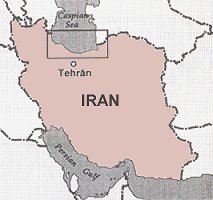The Caspian Sea is the world's largest lake and is surrounded by the following countries - Iran, Russia, Turkmenistan, Azerbaijan and Kazakhstan. Covering an area of 370,000 sq. kilometres (229,635 sq. miles) and measuring 1210 kilometres (751 miles) from north to south and between 210 kilometres (130 miles) and 436 kilometres (271 miles) from east to west; the Caspian is five times bigger than the largest lake (Lake Superior, on the Canadian US border), and contains 44% of all the water in the world's lakes. The Caspian has many large tributaries, such as the Volga, Zhem and Ural rivers, but has no outlet to the ocean. It is home to a vast number of fish, including the sturgeon that produce caviar, migratory birds, tortoises and the unique Caspian seal.
The Iranian coast of the Caspian stretches for 630 kilometres (391 miles) from Astara in the west, on the border with the Republic of Azerbaijan, to the Bandar-e Torkaman region in the east, near the Republic of Turkmenistan.
Two provinces Gilan and Mazanderan occupy this coastal belt, and have a varied terrain, with thick forests, mountains and a coastal plain. The towering Alborz rises to over 3,658 metres (12,000 feet) and separates the Iranian plateau from the Caspian coast acting as a barrier preventing the moisture from the Caspian entering in land. As a result while the southern flanks of the Alborz are almost entirely bare of vegetation, its northern slopes are covered with thick forests and rice paddies. In southern Mazanderan the forest is rich with wildlife. Much of it is impenetrable and gives cover to a wide range of animals, including wild boar, jackal, leopard and tiger.
Caviar is fished at more than 50 areas along the Iranian part of the Caspian coast, but most of it is caught near Bandar-e Torkaman in the Mazanderan province. Normally dozens of large wooden boats, with huge mesh nets, catch the sturgeon, though in recent times, Shilat (1) has established hatcheries to ensure continuing supplies.
The rainy Caspian climate is ideal for growing rice and tea - the main agricultural crops of the region. More than 90% of the tea grown in Iran comes from the Gilan province. Cotton is also harvested in both provinces, and oranges and other citrus fruits are becoming increasingly important crops in Mazanderan. |
